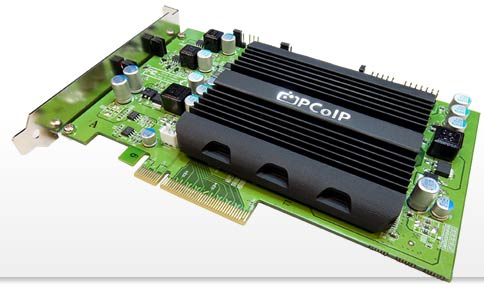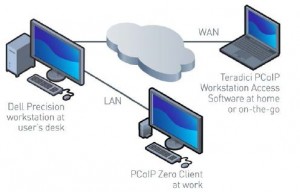Film studios and computer vendors want to extend their remote computing.
Siggraph was an important show for Teradici. Their PCoIP (PC over IP) is being used by the major hardware vendors including Dell and Lenovo, and at Siggraph 2014 we were told by the studio CTOs and IT chiefs that Teradici has enabled them to take advantage of virtualization. Pixar’s VP of Systems, John Kirkman says that Pixar has chosen Teradici for remote computing because Teradici’s approach “is basically lossless.” He says, “They’re taking the actual image and compressing it; we trust that more. We know no one is manipulating the pixels, and that’s super important to us.”
The PCoIP at the source compresses, encrypts, and transports image pixels to the end devices, where they are decrypted and displayed. At Siggraph, Teradici unveiled a software product it has developed that will enable people using tablets, mobiles, and light PCs to access remote data and display it wherever they are.

Obviously, low latency is important for people using remote workstations or they wouldn’t even consider using a remote solution. In this case, they’re using a hardware accelerator, Teradici’s Apex 2800. The company says it reduces the CPU overhead by offloading the most active virtual displays. The system works with shared GPU or GPU pass-through configurations.
In the case of graphics-heavy applications, the Teradici hardware accelerator works with a physical GPU on VMware Horizon View software. In this situation, the hardware accelerator increases the frames per second delivered to the remote endpoint to eliminate the perception of latency. The system is secure because the PCoIP protocol transfers images as pixel location information. The software is located within the central system so it is safe from malware introduced by application infiltration, and the encryption algorithms, AES 256 and NSA Suite B, meet government requirements.
The system enables users to work across multiple displays, use USB peripherals, and send and receive high-definition audio.
Dell and Teradici’s software approach
At Dell’s Siggraph event, Andy Rhodes told the audience that nothing really gets replaced; all this technology tends to be additive—people keep the workstation at their desk, but they add to it with remote computing. As a matter of fact, Lincoln Wallen of DreamWorks talked about remote computing as a force multiplier, enabling people to be much more efficient. In the case of the software version of Teradici’s PCoIP technology, it’s expected that users will use it to complement their hardware systems. For instance, in a conference room, it would be easy to pull up content from the workstation back at the desk or the workstation in the data center. People working from home will be able to get to their work back in the office with the same security assured.

The companies see this addition as an enabling tool for small and midsized businesses in architecture, construction, engineering, and manufacturing. The software client can be easily and instantly installed. Dell is making it available through its online store and through Dell’s channel partners. It is priced at $199 plus $40 for a one-year mandatory support and maintenance contract, which includes free software upgrades and 24/7/365 support services.
Teradici says the PCoIP Workstation Access Software will be available in North America in August and will begin its global rollout late in the first half of 2015. The software is optimized for Nvidia’s K2000 or higher via the Grid SDK 2.2, it is compatible with any discrete GPU from AMD and Nvidia, and it takes advantage of the latest 3D APIs, OpenGL and DirectX.
The first round of clients supported including Windows and Mac PCs and PCoIP Zero Clients from Wyse. Support for additional endpoints is planned for future releases. We’re assuming that Teradici’s PCoIP Workstation Access Software will be released for other OEM workstations down the road.





